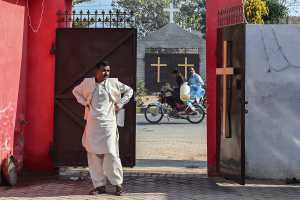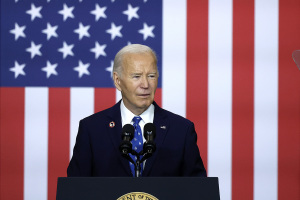Worship Meets New Technology at Conference
LAS VEGAS — Darryl Davis came to a city famous for sin with a more virtuous mission: finding ways for his church to bring old-time worship into a high-tech world.
"If you want to spread that Gospel effectively, to reach this younger generation, you have to have technology available, because it’s become so common to them," said Davis, technical director for the Fellowship Bible Baptist Church in Warner Robins, Ga. "It is becoming a necessity for most churches."
Finding a path for worship in a world of Web sites, cell phones and high-definition television was the focus April 18-21 at the second annual Worship Technology Conference at the National Association of Broadcasters show.
Lectures and workshops on everything from tailoring church lighting and acoustics for television broadcasts to finding architects for a high-tech sanctuary drew more than 200 people to the event.
"As the world has changed, the church hasn’t really kept up in many ways with communicating its message in a way that’s relevant and attractive," said Jason Moore, a founder of Midnight Oil Productions, which holds worship media workshops and sells graphics, books and packaged church services.
In a session called "Worship in the Digital Age," Moore and his partner, Len Wilson, said many churches have projectors, big screens and computers, but have yet to embrace technology’s full potential beyond simple PowerPoint displays of Scripture and lyrics.
That’s not enough for increasingly tech-savvy churchgoers, they said. Reaching them requires a blend of audio and video technology and a more modern approach to teaching often obscure biblical lessons from ancient times.
"The most powerful metaphors are the metaphors from the culture we live in," said Moore, who is based in Dayton, Ohio.
A "multi-sensory worship" service they designed and have sold to churches updates the biblical imagery of separating the wheat and chaff with a modern metaphor for purity: filtering coffee.
Such a service, they said, might include sermons intermingled with video, music, the smell of brewing coffee and congregants writing what needs to be purified from their lives on coffee filters, which are thrown away in a symbolic fashion.
"Jesus’ use of parables very much fits with this idea," said Wilson, who works from outside Dallas.
Inspired by the animated announcement films that run before movies, they created a church video that included instructions like "Talking and praying are encouraged" and "Feel free to jump out of your seat at any time."
They used this video at a movie-themed service at the Ginghamsburg Church outside Dayton, where Wilson was once media minister. They also had popcorn popping outside the sanctuary and theater seats on stage.
The goal, they said, is to have people in their daily lives thinking back to sermons and services when they do things like drink coffee or go to the movies.
"The culture becomes a reminder of the Gospel," Moore said. "The best thing about that is the culture is inescapable."
Churches going high-tech is big business, said Anthony Coppedge, a church media consultant and licensed minister from Bedford, Texas. The church market for commercially installed audio, video and lighting equipment is the industry’s fastest growing and is worth about $1 billion each year.
Churches typically are about a decade or two behind secular society in adopting technology, and so are just now catching up to the digital boom of the 1980s and ’90s, Coppedge said.
While broadcast ministries and high-tech worship have gained popularity through "megachurches" — some have tens of thousands of members — the trend has begun to trickle down to smaller congregations.
Major electronics firms have noticed, and see an untapped market for their products.
Coppedge said he attended the NAB show to advise interested manufacturers, including Apple Computer Inc., Sanyo Electric Co. and Sony Corp.
Sony Electronics sponsored a series of breakfasts at the worship conference and showed off its latest high-definition video equipment, saying its presentations were "aimed at taking the art of ministry to a higher level, figuratively speaking."
Improved technology and declining costs have made creating professional-quality video affordable for more churches, said Peter DiIorio, a senior Sony product manager. He said Sony has paid particular attention to the church market in the last two years, and now "we’re ramping up our activity."
Speakers at the conference, which was co-produced by Te c h - nologies for Worship magazine, often referenced the growing staple of software products intended for church presentations such as EasyWorship and SundayPlus, which contain databases of lyrics, biblical images and Scripture.
But going high-tech is not for every church, said Coppedge. For example, he said, magnified video of a pastor is a distraction in a small church where people can already see fine.
"It’s not the application of technology for the sake of technology," he said. "It’s the use of technology to enhance and support the message."





























